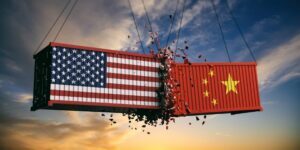By: Brandon French, Associate Attorney, Braumiller Law Group
President Trump signed the Phase 1 Agreement with China on January 15, 2020. As part of the agreement, China has pledged to purchase $200 billion worth of goods and services over the next two years – this would be a 50% increase from the current levels. The $200 billion worth of goods and services is broken down into four main categories over 2020 and 2021: (a) manufactured goods, (b) agricultural goods, (c) energy goods, and (d) services. China has also promised to provide additional protection to U.S. companies’ intellectual property. Moreover, China will not be allowed to require U.S. companies to share technology if they want to do business in China.
Maybe even more important for businesses is how the agreement affected the Section 301 tariffs. For instance, the List 4B tariffs which were scheduled to go into effect in December 2019 have now been suspended. Additionally, the List 4A tariffs are scheduled to decrease from 15% to 7.5% on February 14, 2020. However, the List 1, 2, and 3 tariffs will remain at 25% until a Phase 2 Agreement is reached. Because the majority of tariffs remain, most companies are actively reviewing new exclusions that are published by the United States Trade Representative (USTR) approximately every 2-3 weeks. It is important for importers to closely monitor their products to determine if an exclusion applies to them. If a company thinks a product qualifies for an exclusion, it should: (1) review and confirm the classification of the item; (2) verify it fits within the specific language of the exclusion provision; and (3) review the company’s ACE data to determine the status of the applicable entries. Step 3 is important because it determines the appropriate way to obtain refunds. For instance, if the entries are within the 314 liquidation cycle, companies should contact their brokers to file a post-summary correction. However, if the entries have already liquidated but are still within 180 days after liquidation, the importer can file a protest.
Performing a review of your import data will help determine the best avenue for obtaining refunds and the applicable deadlines for doing so. Furthermore, if you have determined that an exclusion applies, you should also review when the exclusion expires. So far, the USTR has released two separate comment periods for exclusions granted in December 2018 and March 2019 to give interested parties an opportunity to explain why an exclusion should be extended for an additional year. It is likely that these extension periods will continue, so it is important to continuously monitor the USTR website for any updates. Lastly, companies should not assume that an extension request will be submitted for an active exclusion. Meaning, it is unlikely the USTR will extend an exclusion unless a written comment is submitted. For example, of the original 7 full HTS codes, and 23 product specific exclusions that were approved from the December 28, 2018 notice, the USTR only extended 2 full HTS codes and 4 product specific exclusions. The fact that only a small portion of exclusions were extended should tell businesses to actively review which exclusions they currently can take advantage of to make sure any necessary comments are filed once an extension process is opened.
For any additional inquiries, or if you would like to discuss updates with the Chinese Trade war in more detail, please contact Brandon French at Brandon@braumillerlaw.com.

